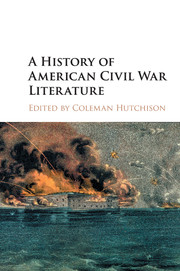Book contents
- Frontmatter
- Dedication
- Contents
- List of Illustrations
- Notes on Contributors
- Preface
- Acknowledgments
- Part I Contexts
- Part II Genres
- Part III Figures
- 12 Walt Whitman
- 13 War and the Art of Writing: Emily Dickinson's Relational Aesthetics
- 14 Herman Melville and the Civilian Author
- 15 Looking at Lincoln
- 16 Frederick Douglass, Violence, and Abraham Lincoln
- 17 Mary Boykin Chesnut: Epic and Miniature
- 18 Mark Twain
- 19 Replay: William Faulkner and the Civil War
- 20 Robert Penn Warren's Civil War
- 21 Natasha Trethewey's Civil War
- 22 Afterword: Archiving the War
- Recommendations for Further Reading
- Index
19 - Replay: William Faulkner and the Civil War
from Part III - Figures
Published online by Cambridge University Press: 05 December 2015
- Frontmatter
- Dedication
- Contents
- List of Illustrations
- Notes on Contributors
- Preface
- Acknowledgments
- Part I Contexts
- Part II Genres
- Part III Figures
- 12 Walt Whitman
- 13 War and the Art of Writing: Emily Dickinson's Relational Aesthetics
- 14 Herman Melville and the Civilian Author
- 15 Looking at Lincoln
- 16 Frederick Douglass, Violence, and Abraham Lincoln
- 17 Mary Boykin Chesnut: Epic and Miniature
- 18 Mark Twain
- 19 Replay: William Faulkner and the Civil War
- 20 Robert Penn Warren's Civil War
- 21 Natasha Trethewey's Civil War
- 22 Afterword: Archiving the War
- Recommendations for Further Reading
- Index
Summary
“They mought have kilt us, but they aint whupped us yit, air they?”
William Faulkner, Absalom, Absalom!Most of William Faulkner's novels are set in his imaginary county of Yoknapatawpha, located in a fictionalized version of his actual state of Mississippi. Over the nearly four decades of his career, from the mid-1920s to the early 1960s, Faulkner composed an elaborate saga of modern life from his vantage point in the U.S. South. His literary domain, for which he once made a hand-drawn map and signed it “sole owner and proprietor,” attempts the comprehensive depiction of a single place through more than a century of its existence. Faulkner brought to life a Shakespearean assortment of characters: ambitious but ruthless frontier planters; their wives and children, struggling through generations of the “curse” that descended from those initial acts of hubris; native Americans, clinging to remnants of land once theirs; African slaves, subject to generations of brutality, but determined to be free; small farmers resentful of marginalization and spoiling to see their betters fall – many of these figures scaled as larger-than-life grandees and grotesques.
As Faulkner's generations of characters interact with each other, they also confront historical events that reshaped sharply their regional, national, and global circumstances. Faulkner's literary project from the outset was widely understood as chronicling the South's passage into modernity, its transformation from a feudal agrarian society to one of town mercantilism. Faulkner portrayed a range of attitudes toward such upheaval, from the sense of grief-stricken loss exemplified by the Compson gentry in The Sound and the Fury, to the opportunism embraced by the rags-to-riches “redneck” clan of Snopeses, the desperate urgency of women suddenly catching sight of freedom from Southern paternalism, and the setting of African Americans’ sights on nothing less than equality at last.
Although the changes associated with the South's entry into modernity center in the 1920s and 1930s, when Faulkner was writing his best-known novels, many of his characters identify the much earlier event of the Civil War as triggering the South's transformation. The literary critic Richard Godden has described this century of change as the South's “long revolution,” a series of ruptures through which the South lurched toward a conflicted modernity. From this standpoint, Faulkner positions the Civil War in his fiction as something like the South's predominant “screen memory.”
- Type
- Chapter
- Information
- A History of American Civil War Literature , pp. 288 - 302Publisher: Cambridge University PressPrint publication year: 2015



